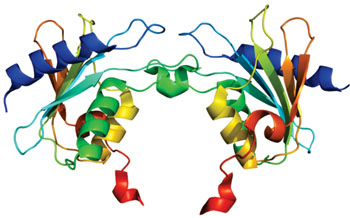Salvage of DNA Precursors Is Lethal to Some Cancer Cells
By LabMedica International staff writers
Posted on 05 Aug 2015
Cancer cells overexpress the enzyme cytidine deaminase (CDA), which allows them to recycle inappropriate DNA precursors but renders them susceptible to genetic damage and cell death.Posted on 05 Aug 2015
Cells require nucleotides to support DNA replication and repair damaged DNA. In addition to making these DNA precursors from scratch, cells recycle nucleotides from the DNA of dying cells or from cellular material ingested through the diet. However, salvaged nucleotides come with the complication that they can contain epigenetic modifications such as being methylated or phosphorylated.

Image: Structure of the CDA protein (Photo courtesy of Wikimedia Commons).
In humans, cytidine deaminase is an enzyme involved in pyrimidine salvaging that is encoded by the CDA gene. This protein forms a homotetramer that catalyzes the irreversible hydrolytic deamination of cytidine and deoxycytidine to uridine and deoxyuridine, respectively. It is one of several deaminases responsible for maintaining the cellular pyrimidine pool. Mutations in this gene are associated with decreased sensitivity to the cytosine nucleoside analogue cytosine arabinoside used in the treatment of certain childhood leukemias.
Investigators at the University of Oxford (United Kingdom) reported in the July 22, 2015, online edition of the journal Nature that in normal cells the enzymes of the nucleotide salvage pathway displayed substrate selectivity, effectively protecting newly synthesized DNA from the incorporation of epigenetically modified forms of cytosine. Thus, cell lines and animals could tolerate high doses of these modified cytidines without any deleterious effects on physiology.
In contrast, by screening cancer cell lines for growth defects after exposure to 5hmdC (5-hydroxymethyl-2′deoxycytidine), the investigators unexpectedly identified a subset of cell lines in which 5hmdC or 5fdC (5-formy-2′deoxycytidine) led to cell death. Using genomic approaches, they showed that the susceptible cell lines overexpressed CDA. CDA converted 5hmdC and 5fdC into variants of uridine that were incorporated into DNA, resulting in accumulation of DNA damage, and ultimately, cell death.
"In the past few years we and others discovered a new set of biological DNA modifications. In the current study, our research group sought to find out what happens to these modified bases when DNA is recycled," said senior author Dr. Skirmantas Kriaucionis, assistant member of the Ludwig Institute for Cancer Research at the University of Oxford. "We were excited that our biochemical analysis uncovered "loopholes," which we hope can be exploited for intervention in cancer. It has been suggested that CDA inactivates cytidine analogues that are already used in the clinic to treat some blood and pancreatic cancers. In a strikingly reverse scenario, the nucleotides that we used in our study are relatively harmless until they encounter CDA, which converts them into hostile cytotoxic agents."
Related Links:
University of Oxford













